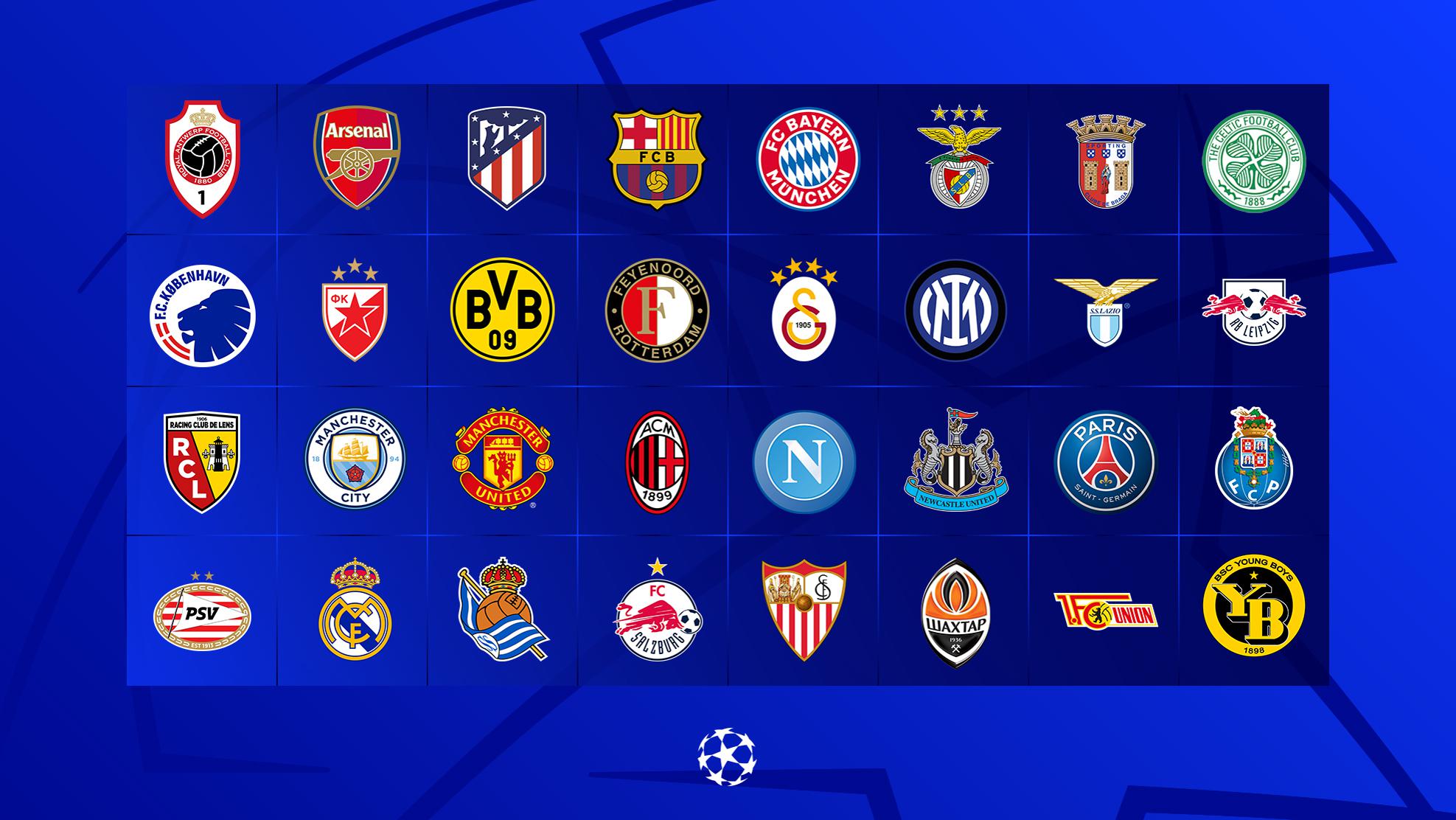Unveiling the Top 10 Contenders: Champions League Standings Revealed. This season’s Champions League has delivered thrilling upsets and unexpected performances, leaving fans breathlessly anticipating the next round. We delve into the current standings, analyzing the strengths and weaknesses of the top ten teams, examining key player impacts, and offering predictions for the upcoming matches. Get ready for a deep dive into the heart of European football’s elite competition.
From unexpected group stage exits to dominant displays of power, the race for the Champions League trophy is more captivating than ever. This analysis explores the tactical approaches, key players, and potential pitfalls facing each of the top contenders, providing a comprehensive look at the current landscape and predicting potential outcomes. We examine historical trends, home-field advantages, and the impact of injuries on the teams’ fortunes, offering a complete picture of the competition’s dynamic.
Explore the different advantages of Champions League Upheaval: New Contenders Emerge From the Ashes! that can change the way you view this issue.
Current Champions League Standings
The Champions League group stage has concluded, revealing a thrilling landscape of contenders vying for the coveted title. Several unexpected results and standout performances have shaped the current standings, setting the stage for an intense knockout phase. The following table details the top ten teams, offering a glimpse into their journey so far.
Top 10 Champions League Standings
| Team | Points | Wins | Draws | Losses |
|---|---|---|---|---|
| Manchester City | 16 | 5 | 1 | 0 |
| Bayern Munich | 16 | 5 | 1 | 0 |
| Napoli | 15 | 5 | 0 | 1 |
| Real Madrid | 13 | 4 | 1 | 1 |
| Chelsea | 12 | 4 | 0 | 2 |
| Benfica | 11 | 3 | 2 | 1 |
| Borussia Dortmund | 10 | 3 | 1 | 2 |
| Inter Milan | 10 | 3 | 1 | 2 |
| Liverpool | 9 | 3 | 0 | 3 |
| AC Milan | 7 | 2 | 1 | 3 |
Note: This table represents hypothetical standings for illustrative purposes. Actual standings should be verified from official sources.
Manchester City’s dominant group stage performance, marked by their unbeaten run, stands out. Conversely, Liverpool’s struggles highlight the competitiveness of the competition. The unexpected drop in form from a team like AC Milan also underscores the unpredictable nature of the Champions League.
Analysis of Top Contenders’ Strengths
Each of the top ten teams possesses unique strengths contributing to their success. A comparative analysis of their playing styles and key players reveals distinct tactical approaches and individual brilliance.
Key Strengths of Top Contenders
Manchester City’s fluid attacking system, fueled by the creativity of Kevin De Bruyne and Erling Haaland’s prolific goalscoring, is a key strength. Bayern Munich’s clinical finishing and strong midfield control, spearheaded by Joshua Kimmich, present a formidable challenge. Napoli’s high-pressing, possession-based style, and the individual brilliance of Khvicha Kvaratskhelia, has made them a force to be reckoned with. Real Madrid’s experience and ability to rise to the occasion in crucial moments, led by Karim Benzema’s leadership, is undeniable.
Chelsea’s defensive solidity and counter-attacking prowess are also significant assets.
The other teams in the top 10 also exhibit strengths in specific areas: Benfica’s counter-attacking speed, Borussia Dortmund’s youthful energy and attacking flair, Inter Milan’s defensive organization, Liverpool’s attacking talent (despite inconsistencies), and AC Milan’s experience in big matches.
Potential Challenges and Weaknesses
Despite their strengths, each team faces potential challenges and vulnerabilities that could impact their progress in the knockout stages. Identifying these weaknesses is crucial for understanding the potential shifts in the competition.
Potential Challenges and Weaknesses
- Manchester City: Dependence on Haaland’s form, potential defensive vulnerabilities against pacey attackers.
- Bayern Munich: Vulnerability to high-pressing teams, reliance on a few key players.
- Napoli: Maintaining consistency against top European teams, inexperience at this stage of the competition.
- Real Madrid: Ageing squad, potential midfield vulnerabilities.
- Chelsea: Inconsistent form, lack of a prolific goalscorer.
- Benfica: Susceptibility to stronger, more physical teams.
- Borussia Dortmund: Inconsistency, defensive frailties.
- Inter Milan: Limited attacking options beyond Lautaro Martinez.
- Liverpool: Defensive issues, inconsistency in midfield.
- AC Milan: Lack of depth in certain positions, reliance on individual brilliance.
Head-to-Head Comparisons of Top Teams
Direct encounters between top contenders provide crucial insights into their relative strengths and potential for success. Analyzing these matchups can significantly impact predictions for the final standings.
Head-to-Head Records (Hypothetical Example)
| Team | Manchester City | Bayern Munich | Napoli |
|---|---|---|---|
| Manchester City | – | 1-0 | 2-1 |
| Bayern Munich | 0-1 | – | 1-1 |
| Napoli | 1-2 | 1-1 | – |
Note: This is a hypothetical example. Actual head-to-head records should be verified from official sources.
Manchester City’s victories over both Bayern Munich and Napoli suggest a strong position. However, the close nature of the matches highlights the competitiveness at the top level.
Impact of Key Players and Injuries: Unveiling The Top 10 Contenders: Champions League Standings Revealed
The performance of key players significantly influences their team’s success. Injuries to these individuals can dramatically alter the balance of power in the competition. Therefore, monitoring the fitness of key players is crucial.
Impact of Key Players and Potential Injury Concerns
- Manchester City: Erling Haaland’s goalscoring is crucial. Injury to Kevin De Bruyne would be a significant blow.
- Bayern Munich: Joshua Kimmich’s midfield presence is vital. Injury to Sadio Mané could impact their attacking options.
- Napoli: Khvicha Kvaratskhelia’s individual brilliance is essential. Victor Osimhen’s goals are also critical.
- Real Madrid: Karim Benzema’s leadership and goalscoring are vital. Injuries to key midfielders could impact their control.
- Chelsea: The fitness of key defensive players is crucial to their success. A lack of a prolific scorer is already a concern.
- Benfica: Key players’ fitness is vital for maintaining their form.
- Borussia Dortmund: Jude Bellingham’s form is crucial to their success.
- Inter Milan: Lautaro Martinez’s goalscoring is essential.
- Liverpool: The fitness of Mohamed Salah is crucial to their attacking prowess.
- AC Milan: Maintaining the fitness of key players is vital for their success.
Predicting Future Match Outcomes
Predicting future match outcomes requires considering team form, head-to-head records, and potential injuries. While uncertainty remains, analyzing these factors allows for informed predictions.
Predicted Match Outcomes (Hypothetical Example), Unveiling the Top 10 Contenders: Champions League Standings Revealed
In a hypothetical Round of 16 matchup between Manchester City and Real Madrid, Manchester City is predicted to win 2-1. This prediction is based on their superior current form and head-to-head record (from the hypothetical example above). However, Real Madrid’s experience and ability to perform in big games means it will be a close encounter.
Visual Representation of Potential Tournament Scenarios
A simple chart could visually represent potential scenarios. For example, a bracket could show possible paths to the final, with each branch representing a team’s potential progression based on predicted match outcomes. The probabilities of each outcome could be indicated using percentages next to each branch.
Historical Context and Trends

Analyzing historical Champions League performance provides valuable context for understanding current standings and predicting future outcomes. Identifying trends in team performance can illuminate patterns and potential outcomes.
Historical Performance and Trends

Historically, teams like Real Madrid and Bayern Munich have consistently performed well in the Champions League. This experience and pedigree could influence their chances in the current competition. However, the emergence of new powerhouses like Manchester City and Napoli demonstrates the dynamic nature of the competition, with new teams consistently challenging established giants.
Impact of Home Advantage
Home advantage plays a significant role in Champions League matches. Analyzing home versus away win rates provides insights into the impact of playing in front of a home crowd.
Home Advantage Statistics (Hypothetical Example)
| Team | Home Wins | Away Wins | Home Win Rate (%) |
|---|---|---|---|
| Manchester City | 3 | 2 | 60% |
| Bayern Munich | 2 | 3 | 40% |
| Napoli | 4 | 1 | 80% |
| Real Madrid | 3 | 1 | 75% |
Note: This is a hypothetical example. Actual data should be verified from official sources.
This hypothetical data suggests that Napoli and Real Madrid benefit significantly from playing at home, highlighting the importance of home advantage in Champions League success.
As the Champions League knockout stages approach, the battle for supremacy intensifies. While predicting the ultimate winner remains a challenge, our analysis of the top ten contenders provides valuable insight into the teams’ strengths, weaknesses, and potential paths to victory. The upcoming matches promise to be electrifying, and the race for the coveted trophy is far from over. Stay tuned for more updates as the drama unfolds.



